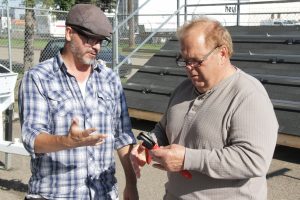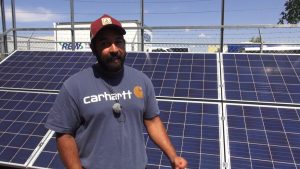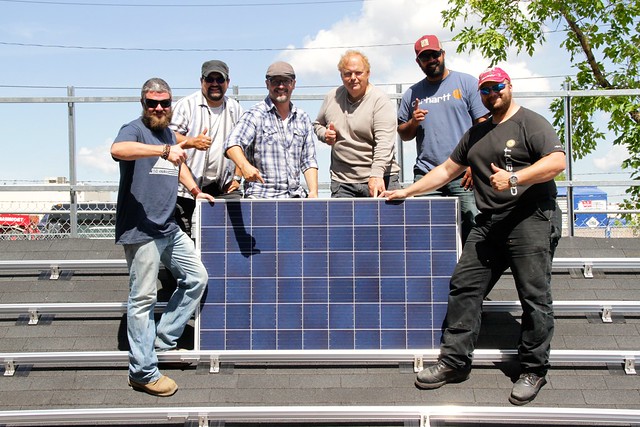By David Dodge and Duncan Kinney
Solar sector employment in the U.S. is booming. It rose 21.8 per cent in employment in 2014 for a total of 174,000 solar workers nationwide, and similar growth is predicted this year. It’s only a matter of time until the solar wave that is rolling across the U.S. comes to Canada. And when it does come we will need trained professionals on the front lines, installing these projects and making sure they’re safe.
Enter Randall Benson. He’s a master electrician who’s been installing solar systems since 2001. His company, Gridworks Energy Group, designs and installs solar PV systems and offers solar PV training out of Edmonton, Alberta.
“People are hearing about solar from all over the world, and they’re asking questions like, “What is this?” and “Can I do this?” and I think they’re probably searching for opportunities,” says Benson.
Green Energy Futures went to solar school. We joined Gridworks for the last day of the five-day solar PV training course that Benson runs at the Gridworks Energy Group training facility. It’s a diverse class. You would expect journeymen and electrical contractors, but architects, engineers and even a former cookbook author-turned-investor/entrepreneur signed up.

Randal Benson with student Dave Wright, entrepreneur, cook book author and budding solar investor. Photo David Dodge, GreenEnergyFutures.ca
Dave Wright has worked in drug stores, has owned pizza franchises and was the man behind the cookbook No Time To Cook in the 1980s.
“I’m here taking the solar course — I thought I’d look at solar because I want to invest in something, and I think solar is the thing,” says Wright.
Wright is optimistic about the future of solar: “I think it’s something that’s going to happen in the future, that’s going to be big. With the change in the government, I think there’s going to be incentives for it. Alberta is so far behind in solar right now compared to the rest of the country, even North America, that I think that it is a good opportunity for anybody that wants to get into the business or into investing in something that has a good potential.”
The five-day solar PV design and installation course is three days of theory with two days of hands-on work installing solar systems. Benson has been doing these training courses for the past six years. He’s trained more than 700 of his colleagues in the International Brotherhood of Electrical workers, but now he’s opening his courses up the public — and he’s seeing a lot of interest.
“Many of my students in the past have started their own businesses, either part-time or even full-time. And it’s really nice to hear that this is happening, because we need qualified electricians doing these jobs,” says Benson. “I like training people. This is what the industry needs: specific training.”
The five-day course isn’t cheap, at $1,695 plus GST, but if you’re looking to get a solar PV system or get into the business of solar PV it’s a great start.
Who is learning about solar PV?

Oilsands worker Amit Kumar wants to start a solar business in the Yukon. Photo David Dodge, GreenEnergyFutures.ca
Amit Kumar is an electrician who actually gets most of his money from working in the oilsands. But he’d love more solar work and he thinks solar is going to grow.
“I’m very optimistic with it. I think there’s a huge, huge industry that’s here and it’s going to happen soon. And I want to be a part of it. It’s the solar industrial revolution,” says Kumar who says he’s working on getting solar going in Canada’s northern Yukon Territory.
Spencer Thornton is a Red Seal journeyman electrician who works in Edmonton and around Alberta for Four Elements Electric. His work is mostly on big commercial/industrial jobs.

Spencer Thornton is a journeyman electrician who sees solar playing a bigger role in the future. Photo David Dodge, GreenEnergyFutures.ca
“I think that things are going to be really positive in the next couple of years, as technologies become a lot better, [and] obviously prices decrease.”
Thornton says using energy from the sun completes the circuit for an electrician: “It’s kind of like a circle of life thing where you take a system that actually takes the sun, produces the energy, and then you produce the systems that use the energy.”
Four Elements Electric is a five year old company with a few dozen employees. Darren Nobrega is the general manager.
“One of our goals is to diversify and get into solar,” says Nobrega. “And we’re taking a more aggressive, proactive approach to training.”
With the change in government in Alberta, he and the others we spoke to expect to see more solar and wind development in Alberta. Indeed, solar is growing fast around the world and it’s just a matter of time until it takes off in Alberta.
Solar and wind made up 74 per cent of new U.S. electricity capacity installed in first five months of 2015. And as the latest U.S. solar market report from Greentech Media shows, installations are going up (especially on residential rooftops) and the price is coming down.
Turnkey installed costs for residential rooftop solar systems are now less than $3.50 per watt. The average price of solar modules (just the hardware) was $76 a watt in 1977; these costs plunged to one one-hundredth of that ($0.74) by 2013.
Solar is becoming a price competitive way of producing electricity, and this seems to bode well for training programs like Benson’s and for the growth of solar.



